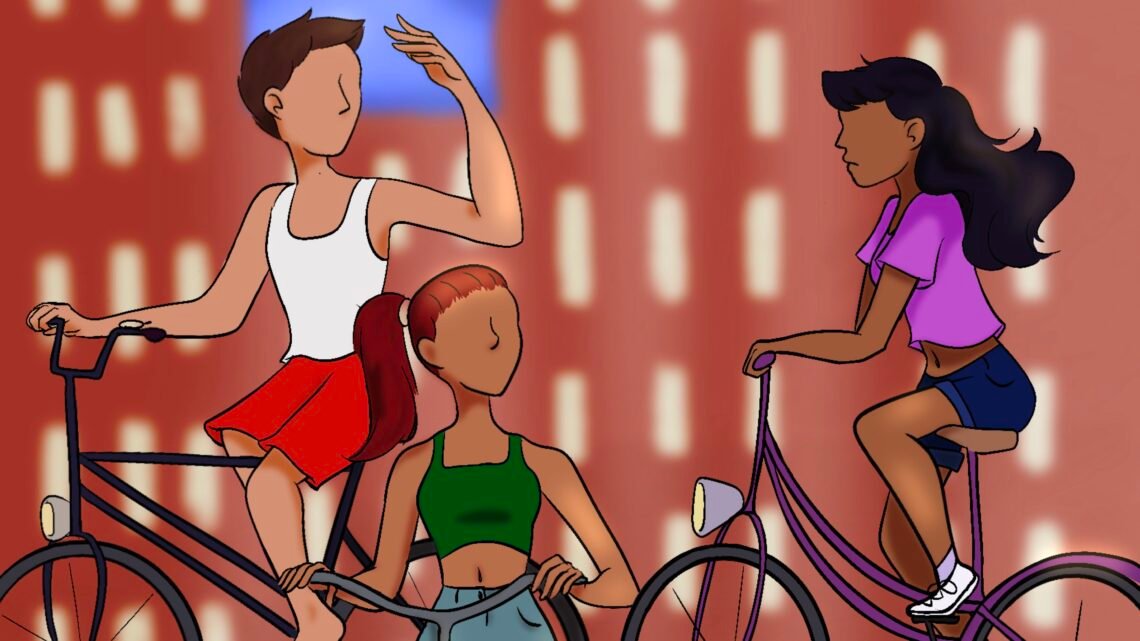Building cycle heaven in Freiburg
Illustration by Taylor Brunnschweiler
An indefinable time ago, I came to the conclusion that routine had taken over my life, and therefore I treated myself to a trip. Call it a moment for reflection. I was thinking of the Himalayas or South America, but in the end, it became Germany. That’s how my travel plans usually go. Partly due to budgetary considerations but also because I feel an inexplicable affinity for the ‘land of poets and thinkers’.
What it also convenient is that Germany is very accessible by train, which is less true for exotic destinations. Nevertheless, I wouldn’t necessarily recommend taking the train now; my (train) travels through Germany in the past often ended up in an infrastructural nightmare. Trains that appear to remain permanently stationary, massive and everlasting construction works and defective overhead lines are all loyal companions when travelling around these parts.[1]
Thinking about these transportation troubles, my thoughts drifted to my personal connections with Germany. Even though I am partly of German descent, I must admit that I wasn’t immediately captivated by the language of Goethe and Schiller, but perhaps this had to do with the somewhat nasal whine of Mrs. Gräfer, my German teacher from South Tyrol back in high school.
But anyway, back to my Germany trip. A good preparation is half the battle, so I searched for a reliable source of information. Luckily, the City Guide Deutschland from ADAC, the German automobile association, was somewhere in the bookcase. It dates back to 2004, but since I know Germany as a country where tradition is highly valued, this is by no means an obstacle for use in 2024. A quick online search taught me, for example, that the recommended guesthouses are (almost) all still in use, only the Rathausstube in Rothenburg ob der Tauber sadly had to throw in the towel due to the corona epidemic.
I felt reassured but at the same time slightly apprehensive by the overwhelming array of must-see destinations in my little guidebook. The last time I visited Germany was two summers ago, and I ended up in Freiburg im Breisgau, the ‘capital of the Black Forest’ in the far southwestern corner of Germany. Freiburg is a beloved base for exploring the region because of the mighty forests that surround it, but the city is also known for its well-preserved old town, sunny climate, and…cycling.
Freiburg advertises itself as the most bicycle-friendly city in Germany. When it comes to cycling, I feel immediately inclined to respond because in the Netherlands, the bicycle is sacred. From senior citizens on e-bikes to packs of cyclists on an off-road trek, in this country the bicycle is used both for daily activities and for trips. If you need to go somewhere you take the bike, as simple as that.
In Germany, however, it is not the bicycle but the car that is sacred; cyclists are usually perceived as annoying pests. Not so in Freiburg. “Freiburg ist eine Fahrrad-Stadt” (Freiburg is a Bicycle City), is proudly stated on the website of the municipality. Experienced observers however quickly realize that this is a bit of an exaggeration. In fact, not much consideration has been given to the infrastructure; in many places, white lines have simply been painted on the road in order to indicate a bike lane.
This can result in dire situations. A drive through the city two summers ago was enough for me to witness a wide range of irritations: a furious cyclist almost being hit by a turquoise Mercedes, irritated motorists, and confused pedestrians.
George Liu, director of the Urban Cycling Institute, a non-profit research organization based in Amsterdam, would not approve of this situation. In his doctoral thesis titled ‘Designing the Cycling City: Towards a User Perspective of Cycling Space’, he emphasizes sustainable transportation planning. A key element in his vision is focusing on the needs of cyclists and having a stress-free cycling environment.
Liu thinks this can be achieved through creating dedicated spaces for cycling, a focus on speed limitations, managing traffic volume and even streetscape beautification. In addition to this, he advocates using standardized elements, such as pavement type and signage shape, in cycling infrastructure to strengthen the relationship between the cyclist and their environment and to help them create a sense of place.[2]
There are countries in Europe where these elements are present. The Netherlands is globally seen as the cycling mecca (I think). A quick search on YouTube reveals that people in Copenhagen are convinced that they live in the best cycling city in the world, but I’m doubtful. I have been to Copenhagen, and from my own experience I know that cyclists there navigate through traffic with sweaty palms. The Netherlands has the best cycling infrastructure, end of story.[3]
But there is hope on the horizon for Freiburg. Entirely on their own, even without my helpful advice, the authorities there have put cycling at the top of the administrative agenda. The municipal website proudly announces that 10 million Euros were invested in cycling infrastructure last year and another 16 million euros will follow suit in the years to come.[4] Not only will lighting and markings be improved, new bike lanes will also be created, and an actual effort will be made (a bit) to separate bicycle traffic from car traffic.
Maybe I’ve been too harsh in my judgment; in Freiburg the signs seem to be pointing in the right direction. There are now more than 400 kilometres of cycling routes available in the wider region, and the city can be reached by ICE from the Netherlands without changing trains, provided, of course, that construction works and overhead line issues don’t throw a spanner in the works. Let me just check what the bike rental prices are over there…
References
[1]https://www.theguardian.com/business/2023/oct/14/its-the-same-daily-misery-germanys-terrible-trains-are-no-joke-for-a-nation-built-on-efficiency
[2] Liu, Y. G. (2022). Designing the Cycling City: Towards a User Perspective of Cycling Space. [Phd Thesis 1 (Research TU/e / Graduation TU/e), Built Environment]. Eindhoven University of Technology.
https://www.theguardian.com/business/2023/oct/14/its-the-same-daily-misery-germanys-terrible-trains-are-no-joke-for-a-nation-built-on-efficiency
[3] https://www.youtube.com/watch?v=HjzzV2Akyds&t=236s&ab_channel=NotJustBikes
[4]https://www.freiburg.de/pb/2130518.html
Taylor Brunnschweiler is a second year studying European Languages and cultures at the university of Groningen. Other than languages, she enjoys cosmetology, illustration and graphic design in general.


